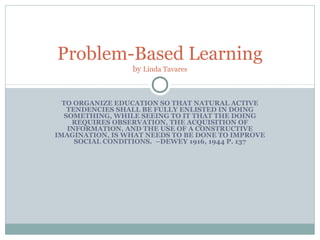
Problem based learning
- 1. Problem-Based Learning by Linda Tavares TO ORGANIZE EDUCATION SO THAT NATURAL ACTIVE TENDENCIES SHALL BE FULLY ENLISTED IN DOING SOMETHING, WHILE SEEING TO IT THAT THE DOING REQUIRES OBSERVATION, THE ACQUISITION OF INFORMATION, AND THE USE OF A CONSTRUCTIVE IMAGINATION, IS WHAT NEEDS TO BE DONE TO IMPROVE SOCIAL CONDITIONS. –DEWEY 1916, 1944 P. 137
- 2. Description Problem-Based Learning (PBL) is a teaching technique that educate by presenting students with a situation that leads to a problem for them to solve. After reading the following articles and book excerpts, you are asked to pick a subject matter that interests you and create a problem for your students to use when engaging in a problem-based learning experience.
- 3. Objective The goal here is to share ideas as well as resources which all EDTC 620 students might refer to as an abundant resource for future lessons. A Power Point Presentation is not required for this assignment.
- 4. Assignement Description After picking a subject that relates to your current classroom, name and describe a current important problem or issue which the subject matter addresses. Perform a web search, looking for information that relates to this problem and analyze the information you find for possible use in an IT-based PBL lesson.
- 5. Procedure Please do not create a formal lesson plan but DO share the following information when you respond: 1. List the subject 2. Grade level 3. Topic 4. Problem 5. A brief explanation of how your lesson might be implemented and why you feel it is a Problem-Based Lesson citing references from the readings. 6. Respond to two of your classmate’s lesson ideas.
- 6. Sequence 1 I suggest the following sequence: First read the following book excerpt from author Robert Delisle titled “How to use Problem-Based Learning in the Classroom” found at this link (read pages iv, v, and 1 – 14): http://books.google.com/books?id=9nZPZ6N27EEC&lp
- 7. Sequence 2 Second read the following book excerpt from author Ann Lambros titled “Problem-Based Learning in K-8 Classrooms: a Teacher’s Guide to Implementation”. This includes the Problem-Based Learning process with sample lessons and lesson format ideas: http://books.google.com/books? id=Fynu9e5ImOMC&lpg=PR7&ots=bcdXZIkjMm&d q=problem%20based%20learning %20guide&lr&pg=PA8#v=onepage&q&f=false
- 8. Sequence 3 Third, if you are teaching at the middle or high- school level, you might want to read “Problem-based Learning in Middle and High School Classrooms”, also written by Ann Lambros: http://books.google.com/books? id=DQHizOhPgXsC&lpg=PR7&ots=yCDH6TUoPR& dq=problem%20based%20learning %20guide&lr&pg=PA2#v=onepage&q&f=false
- 9. Sequence 4 Fourth, to inspire you with examples of problem- based lessons, visit this site from Oregon University that shares many different ideas: http://www.uoregon.edu/~moursund/DigitalAge1/p bl_book_chapter_3.htm
- 10. Optional An additional reading found at the following website is: “Problem-Based Learning: As Authentic as It Gets”, an article by William Stepien and Shelagh Gallagher. A brief description of the article is, “An innovative high school is pioneering ways to engage students in solving problems by having them take on the roles of scientists, doctors, artists, and historians. In addition, the Problem-Based Learning is helping other educators learn these exciting techniques”. http://www.coe.tamu.edu/~rcapraro/Questioning %20and%20Discourse/StepienGalagherPBL.pdf
- 12. Example Name: Linda Tavares Grade: Fourth Subject: Math/economics Topic: Money Problem: The PTA of our school has asked each class to help raise money for needed equipment at our school. They are asking our class to take part in a fundraising drive by creating and selling a product at our school’s next carnival. We must choose to create a product which we can sell during our 1-day carnival that will earn enough profits to purchase a new reading table for our classroom (since the leg on our present table is broken).
- 13. Example Brief explanation of lesson: I will begin my lesson when “one student reads the problem aloud” (Lambros p. 6). Next, students create two lists, one of “Facts” and “Need to Know” concerning the problem. Next, we will discuss what more we need to know or identify “Learning Issues”, a list of things they need to look up (Lambros p.7). Once we identify learning issues we then divide into small groups. The students will work in groups of four and will use laptop computers to investigate resources for purchasing materials while the teacher takes on role of guide or facilitator. For instance, if they decided the best product to create and sell would be lemonade at a lemonade stand, they could visit sites such as Safeway or Food Lion and find out the price of lemons, sugar, cups. They could visit the cafeteria to ask for donations of pitchers and spoons. They must also determine the cost of the table by visiting an office supply store online (or classroom supply store). Once they have determined the cost of items, they will need to determine how much lemonade they will need to sell to cover the cost of the supplies and to make enough profits to purchase the classroom reading table.
- 14. Rationale Rationale: This lesson is an example of a Problem-Based Lesson because the lesson idea includes the classic PBL Process of creating a problem that needs to be solved. It is an inquiry based lesson where students must construct their own knowledge in order to solve the problem. The steps we would use would be to 1. Define the topic, 2. Identify the problem, 3. Establish a timeline, 4. Identify the resources needed to solve, 5. Form teams, 6. Identify possible solutions. We will follow Table 1.1 from “Problem-Based Learning in K-8 Classrooms” and identify a “Facts List, Need to Know, Learning Issues, Possible Solutions, New Learning Issues, and Defendable Solutions” (Lambros p. 8).
- 15. References Lambros, A. (2002). Problem-based learning in k-8 classrooms: a teacher's guide to implementation. Retrieved July 20, 2010 from http://books.google.com/ books? id=Fynu9e5ImOMC&lpg=PR7&ots=bcdXZIkjMm&dq=pro blem%20based%20learning %20guide&lr&pg=PA8#v=onepage&q&f=false